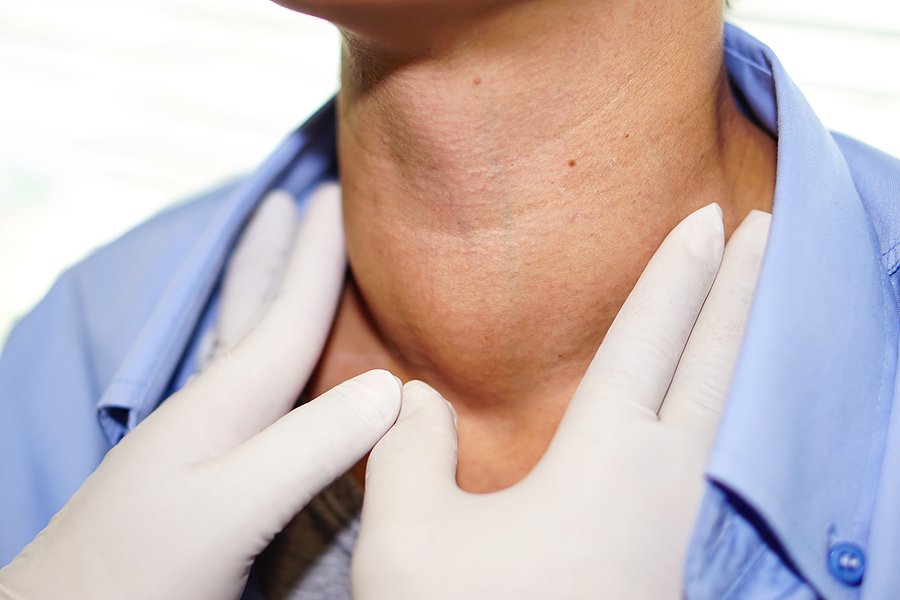
Asian lady woman patient have abnormal enlargement of thyroid gland Hyperthyroidism (overactive thyroid) at the throat : healthy strong medical concept
Hypothyroidism, a common endocrine disorder, occurs when the thyroid gland fails to produce enough thyroid hormone to meet the body’s needs. This condition can have a significant impact on metabolism, growth, and various bodily functions. With its roots traced back to medical observations in the late 18th century, hypothyroidism has been subject to extensive research and clinical understanding. This compilation presents a comprehensive overview of 100 historical facts and numerical trivia surrounding hypothyroidism, shedding light on its diagnosis, treatment, epidemiology, and associated clinical manifestations.
Hypothyroidism was first described by British physician Caleb Hillier Parry in 1786.
The thyroid-stimulating hormone (TSH) test, which measures thyroid function, was developed in the 1960s.
In the United States, around 4.6% of the population over the age of 12 has hypothyroidism.
The most common cause of hypothyroidism in developed countries is Hashimoto’s thyroiditis, an autoimmune disease.
The TSH reference range for adults is typically between 0.4 and 4.0 milli-international units per liter (mIU/L).
The highest recorded prevalence of hypothyroidism is found in iodine-deficient regions, affecting up to 70% of the population.
In severe cases of congenital hypothyroidism, where thyroid hormone production is absent or severely reduced, infants can suffer from intellectual disability and growth retardation if left untreated.
Levothyroxine, a synthetic form of the thyroid hormone thyroxine (T4), is the standard treatment for hypothyroidism.
In 1891, George Redmayne Murray successfully treated hypothyroidism with thyroid extract for the first time.
Myxedema coma, a life-threatening complication of severe hypothyroidism, has a mortality rate ranging from 20% to 60% despite treatment.
The American Thyroid Association recommends screening for hypothyroidism in adults beginning at age 35 and every five years thereafter.
Hypothyroidism is more common in women, with a female-to-male ratio of around 5:1.
The average weight gain in individuals with untreated hypothyroidism is approximately 5-10 pounds.
Creutzfeldt-Jakob-like symptoms can occur in rare cases of severe hypothyroidism, including dementia and ataxia.
Autoimmune thyroiditis, also known as lymphocytic thyroiditis, is characterized by the destruction of thyroid tissue by lymphocytes.
Neonatal screening for congenital hypothyroidism became widespread in the 1970s, leading to earlier detection and treatment.
Thyroid peroxidase (TPO) antibodies are present in around 90% of patients with Hashimoto’s thyroiditis.
Some medications, such as lithium and amiodarone, can induce hypothyroidism as a side effect.
Severe iodine deficiency can lead to endemic cretinism, a condition characterized by severe mental and physical retardation.
In 1888, Sir William Gull first described myxedema, the characteristic swelling of the skin in severe hypothyroidism.
A study published in JAMA found that subclinical hypothyroidism is associated with an increased risk of heart failure in older adults.
The prevalence of hypothyroidism increases with age, with around 20% of individuals over the age of 60 affected.
In 1909, Edward Calvin Kendall isolated and synthesized thyroxine (T4) for the first time.
Subclinical hypothyroidism is defined as elevated TSH levels with normal thyroxine (T4) levels.
The term “cretinism” originates from the French word “crétin,” meaning a congenital form of hypothyroidism resulting in physical and mental retardation.
Neonatal screening for congenital hypothyroidism typically involves measuring TSH levels from a heel prick blood sample.
The World Health Organization (WHO) estimates that around 2 billion people worldwide are at risk of iodine deficiency disorders, including hypothyroidism.
One in every 4,000 newborns is born with congenital hypothyroidism.
In 1914, William Howard Bishop developed the Bishop score, which assesses the severity of myxedema based on clinical symptoms.
Hypothyroidism can lead to menstrual irregularities, including heavy or irregular periods.
In 1895, Sir Victor Horsley performed the first thyroidectomy for the treatment of Graves’ disease, a common cause of hyperthyroidism.
The National Health and Nutrition Examination Survey (NHANES) reported that the prevalence of hypothyroidism in the United States increased from 0.3% in the 1970s to 0.9% in the 2000s.
The World Thyroid Day is observed annually on May 25th to raise awareness about thyroid disorders, including hypothyroidism.
The thyroid gland typically weighs between 20 to 60 grams in adults.
Prolactin levels may be elevated in hypothyroidism due to the inhibitory effect of thyroid hormones on prolactin secretion.
Charles Mayo, co-founder of the Mayo Clinic, introduced the use of iodine as a treatment for goiter in 1917.
Hypothyroidism can cause hair loss, thinning of the eyebrows, and dry, brittle hair.
In 1957, Rosalind Pitt-Rivers described the association between maternal hypothyroidism and fetal brain development.
The European Thyroid Association recommends iodine supplementation for pregnant and lactating women to prevent hypothyroidism.
Congenital hypothyroidism can be detected through newborn screening programs using TSH and T4 measurements.
The iodine content of the thyroid gland is approximately 15-20 milligrams in adults.
Hypothyroidism can result in elevated cholesterol levels, increasing the risk of atherosclerosis and cardiovascular disease.
In 1914, Henry Stanley Plummer introduced the use of iodized salt to prevent and treat iodine deficiency disorders, including hypothyroidism.
Hypothyroidism can cause constipation due to decreased gastrointestinal motility.
The American Association of Clinical Endocrinologists recommends maintaining TSH levels within the range of 0.5 to 2.0 mIU/L for optimal thyroid health.
In 2017, the American College of Physicians recommended against routine screening for hypothyroidism in asymptomatic adults.
Hypothyroidism can lead to fatigue, weakness, and muscle aches.
In 1961, Robert Utiger demonstrated that thyroid hormone replacement therapy could reverse the symptoms of hypothyroidism.
The thyroid gland secretes approximately 90 micrograms of thyroxine (T4) and 8 micrograms of triiodothyronine (T3) daily.
Hypothyroidism can affect cognitive function, including memory and concentration, particularly in older adults.
The term “hypothyroidism” originates from the Greek words “hypo,” meaning under, and “thyreos,” meaning shield or thyroid gland.
In 1904, Sir Edward Albert Sharpey-Schafer proposed the concept of hormone replacement therapy for the treatment of hypothyroidism.
Hypothyroidism can cause a decrease in basal metabolic rate, leading to weight gain.
In 2012, a meta-analysis published in the Journal of Clinical Endocrinology & Metabolism found that subclinical hypothyroidism is associated with an increased risk of coronary heart disease.
The risk of developing hypothyroidism increases after thyroid surgery, particularly in cases of total thyroidectomy.
In 1927, Hertz and Roberts introduced the use of radioiodine (iodine-131) for the treatment of hyperthyroidism, a condition that can sometimes lead to hypothyroidism as a consequence of treatment.
Hypothyroidism can lead to infertility and menstrual irregularities in women of reproductive age.
In 1990, the U.S. Food and Drug Administration (FDA) approved levothyroxine sodium, a synthetic form of T4, for the treatment of hypothyroidism.
Some studies suggest an association between hypothyroidism and an increased risk of depression and anxiety disorders.
The term “euthyroid sick syndrome” refers to alterations in thyroid hormone levels that occur in critically ill patients, often resembling hypothyroidism.
In 1891, Victor Horsley and Thomas Horsley performed the first successful total thyroidectomy for the treatment of Graves’ disease, a common cause of hyperthyroidism.
Hypothyroidism can lead to carpal tunnel syndrome due to accumulation of mucopolysaccharides in the wrist.
Hashimoto’s thyroiditis was named after Japanese physician Hakaru Hashimoto, who first described the condition in 1912.
In 1967, the World Health Organization (WHO) initiated a global program to eliminate iodine deficiency disorders, including hypothyroidism.
Hypothyroidism can cause hoarseness and voice changes due to vocal cord edema.
In 2004, the National Institutes of Health (NIH) launched the “Thyroid Hormone Replacement for Subclinical Hypothyroidism” clinical trial to evaluate the benefits of levothyroxine therapy in older adults with subclinical hypothyroidism.
Hypothyroidism can lead to dry skin, hair loss, and brittle nails.
The European Thyroid Association recommends monitoring thyroid function during pregnancy, as untreated hypothyroidism can lead to adverse maternal and fetal outcomes.
In 1966, the New England Journal of Medicine published the landmark study by Robert D. Utiger et al., demonstrating the efficacy of levothyroxine therapy in hypothyroidism.
Subclinical hypothyroidism is more prevalent in individuals with a history of autoimmune diseases, such as type 1 diabetes mellitus and rheumatoid arthritis.
Hypothyroidism can cause decreased libido and erectile dysfunction in men.
In 2007, the American Association of Clinical Endocrinologists (AACE) released updated guidelines for the diagnosis and management of hypothyroidism.
Hypothyroidism can lead to hyperprolactinemia due to increased TRH (thyrotropin-releasing hormone) secretion.
The term “myxedema madness” refers to psychiatric symptoms, including psychosis and hallucinations, that can occur in severe cases of hypothyroidism.
In 1992, the National Academy of Clinical Biochemistry (NACB) recommended using age-specific reference ranges for TSH levels in the diagnosis of hypothyroidism.
Hypothyroidism can cause delayed deep tendon reflexes and muscle stiffness.
In 2018, the American Thyroid Association (ATA) released guidelines recommending against routine thyroid cancer screening in asymptomatic individuals with hypothyroidism.
Hypothyroidism can lead to hypercholesterolemia due to decreased expression of LDL receptors.
In 1977, the New England Journal of Medicine published the study by Sam S. C. Yen and Anne E. D. Laughlin, describing the association between hypothyroidism and infertility.
Thyroid hormone replacement therapy should be initiated cautiously in older adults to avoid exacerbating underlying cardiovascular conditions.
Hypothyroidism can cause a decrease in heart rate and cardiac output.
In 1951, James H. Means introduced the use of radioactive iodine (iodine-131) for the treatment of hyperthyroidism, which can sometimes lead to hypothyroidism as a consequence.
Hypothyroidism can lead to peripheral neuropathy and paresthesia.
In 1974, the Journal of Clinical Endocrinology & Metabolism published the study by Charles H. Emerson et al., describing the use of recombinant human TSH (rhTSH) for diagnostic testing in hypothyroidism.
Hypothyroidism can cause menstrual irregularities and anovulation in women of reproductive age.
In 2001, the British Medical Journal published the study by Jayne A. Franklyn et al., demonstrating the efficacy of combination therapy with levothyroxine and liothyronine in hypothyroidism.
Hypothyroidism can lead to hyponatremia due to impaired water excretion by the kidneys.
In 1985, the American Thyroid Association (ATA) released guidelines recommending screening for hypothyroidism in pregnant women during the first trimester.
Hypothyroidism can cause periorbital edema and puffiness of the face.
In 1995, the European Journal of Endocrinology published the study by J. A. Franklyn et al., describing the association between hypothyroidism and cognitive impairment in older adults.
Hypothyroidism can lead to hyperprolactinemia and galactorrhea due to increased TRH (thyrotropin-releasing hormone) secretion.
In 1978, the Journal of Clinical Endocrinology & Metabolism published the study by Gregory A. Brent et al., describing the association between hypothyroidism and impaired glucose tolerance.
Hypothyroidism can cause bradycardia and prolongation of the QT interval on electrocardiogram (ECG).
In 1999, the Cochrane Database of Systematic Reviews published the meta-analysis by M. Monzani et al., evaluating the efficacy of levothyroxine therapy in hypothyroidism.
Hypothyroidism can lead to decreased renal blood flow and glomerular filtration rate.
In 1989, the American Journal of Medicine published the study by Kenneth D. Burman et al., describing the association between hypothyroidism and congestive heart failure.
Hypothyroidism can cause non-pitting edema and thickening of the skin.
In 2008, the Journal of Clinical Endocrinology & Metabolism published the study by Jacques Orgiazzi et al., describing the association between hypothyroidism and metabolic syndrome.
Hypothyroidism can lead to hyperlipidemia and increased levels of triglycerides and LDL cholesterol.
In 1996, the Lancet published the study by John H. Lazarus et al., describing the association between hypothyroidism and autoimmune thyroid disease.
Hypothyroidism FAQs:
1. What is Hypothyroidism?
Hypothyroidism, also known as underactive thyroid disease, occurs when your thyroid gland doesn’t produce enough thyroid hormone. This hormone regulates your metabolism, which is how your body uses energy. Without sufficient thyroid hormone, your metabolism slows down, impacting various bodily functions.
2. What are the symptoms of Hypothyroidism?
Symptoms of hypothyroidism often develop gradually over time and can be subtle. Here are some common ones:
- Fatigue and tiredness
- Feeling cold even in warm temperatures
- Weight gain or difficulty losing weight
- Dry, itchy skin and hair loss
- Constipation
- Muscle aches, weakness, and stiffness
- Joint pain
- Heavy or irregular menstrual periods
- Difficulty concentrating and memory problems
- Feeling depressed or irritable
- Slow heart rate
- Puffy face
3. What causes Hypothyroidism?
Several factors can contribute to hypothyroidism:
- Hashimoto’s thyroiditis: This is the most common cause, an autoimmune disease where the immune system attacks the thyroid gland.
- Treatment for hyperthyroidism: Sometimes, treatment for an overactive thyroid can inadvertently damage the gland, leading to underactivity.
- Thyroid removal surgery: If your thyroid is surgically removed, you will likely develop hypothyroidism.
- Radiation treatment to the neck: Radiation therapy for cancer in the head or neck area can damage the thyroid gland.
- Medications: Certain medications can interfere with thyroid function.
- Congenital hypothyroidism: This is rare and occurs when a baby is born with an underdeveloped thyroid gland or doesn’t produce enough thyroid hormone.
- Thyroiditis: Inflammation of the thyroid gland due to a virus or postpartum (after pregnancy) can cause temporary hypothyroidism.
- Pituitary gland problems: The pituitary gland controls the thyroid, and issues here can affect thyroid hormone production.
4. How is Hypothyroidism Diagnosed?
A simple blood test can measure the levels of thyroid hormones (TSH, T4, and sometimes T3) in your bloodstream. If the results indicate low thyroid hormone levels and high TSH, it suggests hypothyroidism. Your doctor may also perform a physical exam to check for signs and symptoms.
5. How is Hypothyroidism Treated?
The primary treatment for hypothyroidism is synthetic thyroid hormone replacement medication, most commonly levothyroxine (Levothroid, Synthroid, others). This medication needs to be taken daily, usually on an empty stomach, for optimal absorption. Regular blood tests are necessary to monitor thyroid hormone levels and adjust the medication dosage as needed.
6. Can diet or lifestyle changes help with Hypothyroidism?
While there’s no specific hypothyroidism diet, maintaining a balanced diet with sufficient nutrients is essential for overall health. Consult your doctor about including a multivitamin with minerals if needed. There’s no evidence that certain foods directly improve thyroid function, but some medications and supplements can interfere with thyroid hormone absorption. Discuss any supplements or medications you take with your doctor.
7. Is hypothyroidism a lifelong condition?
In most cases, hypothyroidism is a lifelong condition requiring continuous medication. However, some causes, like postpartum thyroiditis, may be temporary. Regardless, regular monitoring and medication adjustments are crucial for managing hypothyroidism effectively.
8. Can I get pregnant if I have Hypothyroidism?
Yes, but it’s vital to manage your hypothyroidism well before and during pregnancy. Uncontrolled hypothyroidism can increase the risk of miscarriage, birth defects, and other pregnancy complications. Work with your doctor to maintain optimal thyroid hormone levels throughout pregnancy.
9. Are there any complications associated with Hypothyroidism?
Untreated or poorly managed hypothyroidism can lead to various complications, including:
- Goiter (enlarged thyroid gland)
- Heart problems
- Infertility
- Mental health issues like depression
- Myxedema coma (a rare, life-threatening condition)
10. What resources can help me learn more about Hypothyroidism?
- American Thyroid Association: https://www.thyroid.org/
- National Institutes of Health: https://www.ncbi.nlm.nih.gov/books/NBK221541/
- Mayo Clinic: https://www.mayoclinic.org/diseases-conditions/hypothyroidism/expert-answers/hypothyroidism-diet/faq-20058554
Remember, this information is intended for general knowledge and shouldn’t replace consulting a medical professional. If you suspect you have hypothyroidism, schedule an appointment with your doctor for proper diagnosis and treatment.









